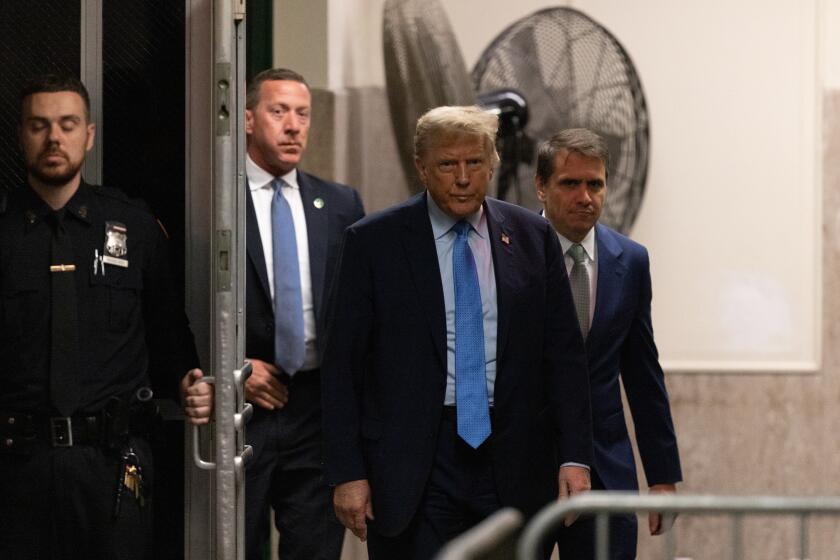Trump’s immigration moves complicate election strategies for both parties
When administration officials briefed reporters at the White House late Wednesday about President Trump’s renewed assault on illegal immigration, a senior official openly spoke about the political advantage they hope to gain.
Democrats say “they do care about border security,” the official said, speaking on condition of anonymity. “But they will have a chance to demonstrate to the American people in the coming days whether or not the Democratic Party wants to officially become the party of open borders.”
“And if they decide to become the party of open borders, I have the feeling that the American voter will be urging them strongly to reconsider that decision,” he said.
Many Democratic strategists believe just the opposite — that Trump’s actions give their candidates an advantage by reminding voters of the president’s unpopular attacks on immigrants and members of minority communities.
Paradoxically, both may be right — at least in part — a chief reason why solving the nation’s immigration problems has proven such an intractable issue in Congress.
Immigration has historically affected the voting public much the way arguments over other cultural issues such as gun control or abortion rights have done, pitting an activated minority of voters on both sides against a majority far less motivated to cast single-issue ballots.
Coupled with the firm views Americans already have on the president — wildly popular among his base and unpopular overall — Trump’s actions may not lead to any huge swing of voters toward or against him.
Yet his moves certainly complicate electoral strategies for candidates heading into the 2018 midterm election and beyond.
“It’s very tricky for both sides,” said Ruy Teixeira, a senior fellow for the Center for American Progress, who has studied the voters who traditionally have most supported border security and opposed illegal immigration.
That is because immigration pulls at threads that already threaten to unravel both parties. Both are trying to balance their need for support from blue-collar voters and college-educated moderates, groups with very different cultural outlooks and economic concerns. Those differences persist even as the distance between Democrats and Republicans on immigration has grown dramatically.
If Trump succeeds in making immigration a bigger issue in this year’s midterm election, it could help Republicans in blue-collar, heavily white districts in the Midwest. It would likely hurt them in suburban areas where college-educated moderates are already alienated from Trump. That divide would echo the calculation the president made in 2016.
For Republicans, Trump’s moves will be greeted enthusiastically among one of his key voter groups: white voters without a college education. Those voters sided with Trump over Hillary Clinton by a 31-percentage-point margin in the 2016 election, according to an exhaustive survey of voter behavior that Teixeira and others conducted last year.
Trump’s vows to close the border and deal harshly with immigrants, both those here illegally and legally, hugely energized his core supporters in the presidential election, according to studies by two nonpartisan organizations, the Pew Research Center and PRRI, a nonpartisan group that studies voter values.
Among the issues that drove voters to support Trump, “that was the one that had the largest impact,” said Carroll Doherty, director of political research at Pew.
At the same time, Trump’s tough rhetoric on immigration has had long-term implications. Turned off college-educated voters contributed to Democratic victories in off-year elections in 2017 and on into this year and are a much sought-after group in this year’s midterm.
“Among a lot of other groups of voters, issues like this are seemingly hurting the president,” said Rob Griffin, associate director of research at PRRI.
Among Democrats, the bulk of the party’s voters are sympathetic to immigrants in the country illegally and unmoved by the president’s insistence that a closed border is necessary for the nation’s security.
Those voters — including minorities, the young and those with college educations — are already firmly in the anti-Trump camp, meaning that the greatest impact of his recent immigration moves may be to further encourage them to cast ballots.
But there’s another group of voters in play on the issue: those who often have voted for Democrats, but who share the cultural concerns of those most supportive of Trump — white, less educated and centered in the key middle-America states that flipped from Democratic to Republican in 2016 and gave Trump the presidency.
Many voters in those states cast ballots for President Obama in 2008 and 2012; then, finding their futures still insecure amid the area’s foundering manufacturing industries, they sided with Trump in 2016. More than other demographic groups, they fear what Griffin termed “cultural displacement” by newcomers.
“It’s the politics of resentment that are really being tapped here,” said Democratic pollster Celinda Lake, speaking of Trump’s rhetoric.
“If you’re in a state that is doing well, you don’t have to worry as much. If you are in a state that’s in a downturn … then you have to worry more about it. It really depends on the economic trend of the state and whether people feel like they are all in this together.”
Fresh from their humbling 2016 defeat, Democrats have been divided over whether to aim for the more liberal voters in the next elections or cast a wider net to try to reclaim voters who backed Trump. That debate affects how party strategists approach immigration issues.
Only a generation ago, Republican and Democratic voters had a similar range of views on immigration. Yet over that span of time, the Republican Party has become dominated by older and whiter voters, while the Democratic Party has grown younger and more diverse. The combination has driven them apart on the issue.
In 1994 — the year that California convulsed over Proposition 187, the measure that would have banned immigrants in the country illegally from state services — just over a quarter of white, high-school-educated voters from both parties said they believed immigrants strengthened the country, a Pew survey showed. In each party, nearly two-thirds of those voters said immigrants were a burden.
Among white college-educated voters, Democrats held more sympathetic views of immigrants — but not dramatically so.
By 2017, Republican views had remained fairly constant while Democrats had grown far more supportive of immigrants. Overall, a plurality of Republicans still considered immigrants a burden more than a strength. But among Democrats, 85% said immigrants strengthened the country, a jump of 52 points in support over a span in which Republican support grew by only 10 points.
The question for Trump is whether he expects his border moves to attract new voters or merely solidify the ones he has. A question for Democrats is whether they will find the message to counter any appeal from his renewed pitch and limit Trump’s reach.
“Looking at the situation right now, in 2018, it doesn’t seem like an issue that can save them,” Teixeira said of the impact of immigration on Republicans, who are widely expected to lose congressional seats in November.
On the other hand, he added, “For the Democrats, they really need to stop the bleeding among white non-college voters.”
Like Teixeira, Democratic pollster Lake said her party needs to counter Trump’s cultural appeals with an economic message that can straddle its competing factions.
“We have a lot more to worry about: that we have no economic message,” she said. “You certainly can’t get white, blue-collar voters without an economic message.”
For more on politics from Cathleen Decker »
Twitter: @cathleendecker
More to Read
Get the L.A. Times Politics newsletter
Deeply reported insights into legislation, politics and policy from Sacramento, Washington and beyond. In your inbox three times per week.
You may occasionally receive promotional content from the Los Angeles Times.







